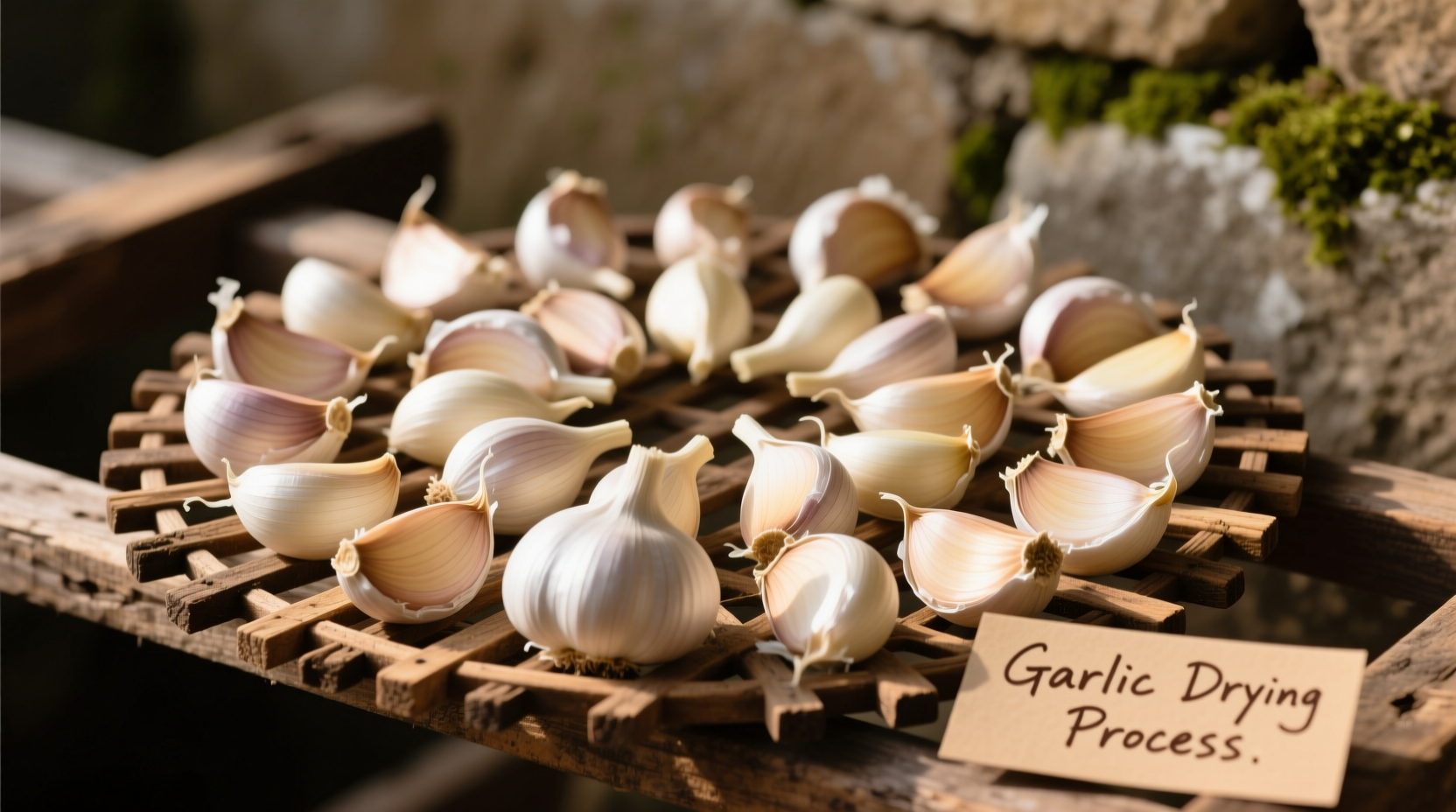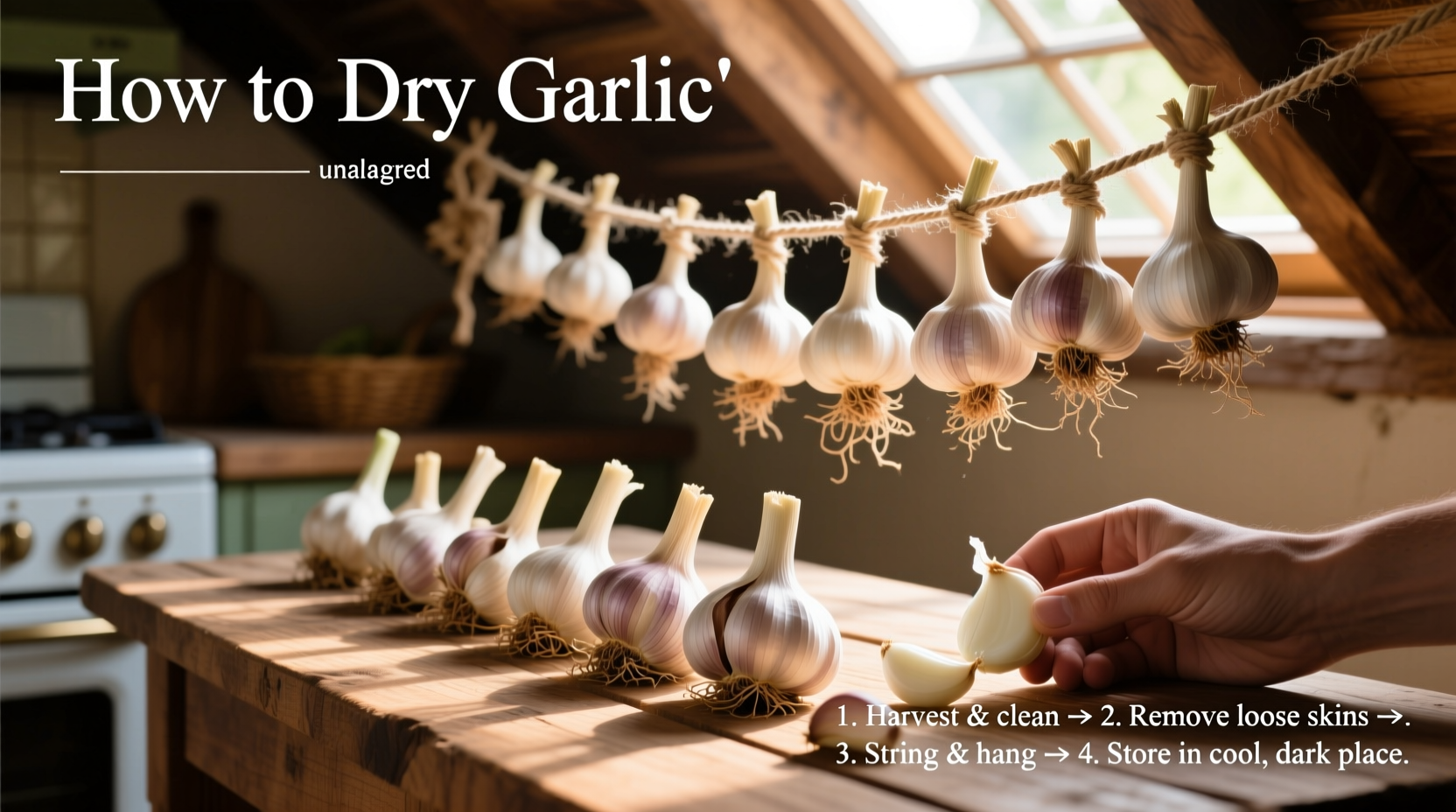Drying garlic at home preserves its flavor for up to 12 months using three proven methods: air drying, oven drying, or food dehydrator. Properly dried garlic should reach 10-15% moisture content, feel brittle when broken, and snap cleanly without bending. Follow these science-backed steps for safe, flavorful results every time.
Preserving garlic through drying transforms your harvest into a shelf-stable pantry staple while concentrating its savory flavor. Whether you've grown your own crop or bought a bulk supply, proper dehydration prevents spoilage and creates versatile garlic for cooking year-round. This guide reveals the exact techniques professional chefs and food preservation experts use to achieve perfect results.
Why Dry Garlic Instead of Storing Fresh?
Fresh garlic typically lasts 3-6 months under ideal conditions, but drying extends its shelf life to 12 months while intensifying flavor. According to USDA National Center for Home Food Preservation guidelines, properly dried garlic maintains nutritional value while eliminating moisture that causes mold and bacterial growth. Dried garlic also takes less storage space and works better in spice blends than fresh cloves.
Preparing Garlic for Drying: The Critical First Step
Successful drying begins with proper preparation. Harvest or purchase firm, unblemished bulbs with tight skins. Avoid sprouted or soft cloves as they won't dry properly.
Cleaning and Separating
Gently brush off dirt without washing—moisture complicates drying. Separate cloves but keep skins intact for most methods. For dehydrator use, peel cloves to reduce drying time. The University of California Cooperative Extension confirms that unpeeled cloves retain more flavor compounds during dehydration.

Drying Methods Compared: Which Works Best?
| Method | Time Required | Temperature | Moisture Target | Best For |
|---|---|---|---|---|
| Air Drying | 3-6 weeks | Room temperature | 10-15% | Whole bulbs, traditional preservation |
| Oven Drying | 6-12 hours | 140°F (60°C) | 10-15% | Quick results, small batches |
| Food Dehydrator | 8-15 hours | 135°F (57°C) | 10-15% | Consistent results, larger quantities |
This comparison reflects data from the National Center for Home Food Preservation, showing optimal parameters for safe, effective garlic dehydration. Temperature control proves critical—exceeding 150°F degrades allicin, garlic's key flavor compound.
Air Drying: The Traditional Approach
Braiding garlic stems creates attractive bundles while promoting airflow. Follow these steps:
- Cut stems to 6 inches and brush off excess dirt
- Braid 8-12 bulbs together with twine
- Hang in a dark, well-ventilated area with 60-70% humidity
- Check weekly for mold or soft spots
- Complete drying takes 3-6 weeks until cloves feel papery
Agricultural research from Cornell University confirms that air drying preserves more volatile sulfur compounds than heat methods, creating richer flavor. However, this method requires stable humidity—above 70% increases mold risk.
Oven Drying: Fast Results with Precision
For quick dehydration without special equipment:
- Preheat oven to its lowest setting (ideally 140°F/60°C)
- Place unpeeled cloves on parchment-lined baking sheet
- Prop oven door open 2-3 inches with wooden spoon
- Dry for 6-12 hours, checking hourly after first 4 hours
- Rotate tray periodically for even drying
Food scientists at the University of Massachusetts warn that oven temperatures often fluctuate above recommended levels. Use an independent oven thermometer for accuracy—excessive heat creates bitter, leathery garlic.
Food Dehydrator Method: Most Consistent Results
For reliable, hands-off drying:
- Peel cloves and slice 1/8 inch thick for even drying
- Arrange in single layer on trays without overlapping
- Set temperature to 135°F (57°C)
- Dry 8-15 hours until cloves snap when bent
- Condition for 7-10 days in airtight container before final storage
According to the National Center for Home Food Preservation, dehydrators maintain precise temperature and airflow, reducing drying time by 50% compared to oven methods while preserving maximum flavor compounds.
Testing for Complete Dryness: The Critical Check
Improperly dried garlic leads to spoilage. Verify dryness using these tests:
- Break Test: Clove should snap cleanly without bending
- Sound Test: Dried cloves make a crisp sound when shaken
- Touch Test: Surface feels completely dry with no moisture
- Internal Check: Cut one open—center should show no translucency
The USDA recommends conditioning dried garlic for one week in airtight containers to equalize moisture. Shake containers daily—condensation indicates insufficient drying requiring additional dehydration time.
Proper Storage: Making Your Dried Garlic Last
Store completely dried garlic using these food safety guidelines:
- Use airtight glass jars or vacuum-sealed bags
- Include oxygen absorbers for long-term storage
- Keep in cool, dark place below 70°F (21°C)
- Label with drying date for rotation
University of Georgia research shows properly stored dried garlic maintains quality for 12 months. Beyond this, flavor gradually diminishes though remaining safe to eat. For extended storage beyond 18 months, freeze in airtight containers.
Using Dried Garlic in Cooking: Flavor Maximization Tips
Dried garlic offers concentrated flavor but requires different handling than fresh:
- Rehydrate in warm water or broth for 15 minutes before use in moist dishes
- Grind to powder for spice blends using a coffee grinder dedicated to spices
- Use 1 teaspoon dried garlic equals 1 fresh clove in recipes
- Add early in cooking for soups and stews to rehydrate fully
- Toast lightly in oil before adding to dishes for enhanced flavor
Chef Antonio Rodriguez notes: "Dried garlic develops deeper umami notes than fresh. For maximum flavor extraction, always toast dried garlic in oil before adding other ingredients—this releases the fat-soluble flavor compounds that water alone won't activate."
Troubleshooting Common Drying Problems
Address these frequent issues with proven solutions:
- Mold development: Caused by insufficient airflow or high humidity. Discard affected cloves immediately and increase ventilation.
- Leathery texture: Result of excessive heat. Reduce temperature and extend drying time.
- Bitter flavor: Occurs when temperature exceeds 150°F. Use lower heat settings next time.
- Inconsistent drying: Rotate trays regularly and ensure uniform slice thickness.
Food safety experts emphasize that any garlic showing mold must be discarded entirely—surface mold indicates potential internal contamination.











 浙公网安备
33010002000092号
浙公网安备
33010002000092号 浙B2-20120091-4
浙B2-20120091-4